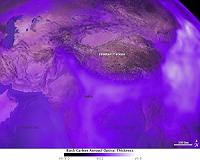| . |  |
. |
Washington (AFP) March 8, 2011 The pace at which the Greenland and Antarctic ice sheets are melting is "accelerating rapidly" and raising the global sea level, according to findings of a study financed by NASA and published Tuesday. The findings suggest that the ice sheets -- more so than ice loss from Earth's mountain glaciers and ice caps -- have become "the dominant contributor to global sea level rise, much sooner than model forecasts have predicted." This study, the longest to date examining changes to polar ice sheet mass, combined two decades of monthly satellite measurements with regional atmospheric climate model data to study changes in mass. "That ice sheets will dominate future sea level rise is not surprising -- they hold a lot more ice mass than mountain glaciers," said lead author Eric Rignot, jointly of NASA's Jet Propulsion Laboratory and the University of California, Irvine. "What is surprising is this increased contribution by the ice sheets is already happening," he said. Under the current trends, he said, sea level is likely to be "significantly higher" than levels projected by the United Nations climate change panel in 2007. Isabella Velicogna, co-author of the study, told AFP that the ice sheets lose mass by melting or by breaking apart in blocks of ice, which float into the ocean. "It's related to the warming of the planet but that was not the point of the paper. We just observed the changes," said Velicogna, a professor at UC Irvine. "It's losing mass -- much more than was expected many years ago." The study showed that in 2006, a year in which comparable results for loss from mountain glaciers and ice caps are available, the Greenland and Antarctic ice sheets lost enough mass to raise global sea level by an average of .05 inches (1.3 millimeters) per year. The year-over-year acceleration rate of loss on mountain glaciers and ice caps was three times smaller than that of the ice sheets, the study said. "The authors conclude that, if current ice sheet melting rates continue for the next four decades, their cumulative loss could raise sea level by 5.9 inches (15 centimeters) by 2050," the report said. "When this is added to the predicted sea level contribution of 3.1 inches (8 centimeters) from glacial ice caps and 3.5 inches (9 centimeters) from ocean thermal expansion, total sea level rise could reach 12.6 inches (32 centimeters)," it said. The findings were published the March edition of Geophysical Research Letters.
Share This Article With Planet Earth
Related Links Beyond the Ice Age
 Soot Packs A Punch On Tibetan Plateau's Climate
Soot Packs A Punch On Tibetan Plateau's ClimateRichland WA (SPX) Mar 08, 2011 In some cases, soot - the fine, black carbon silt that is released from stoves, cars and manufacturing plants - can pack more of a climatic punch than greenhouse gases, according to a paper published in the journal Atmospheric Chemistry and Physics. Researchers at the Department of Energy's Pacific Northwest National Laboratory, the University of Michigan and NOAA found that soot landing o ... read more |
|
| The content herein, unless otherwise known to be public domain, are Copyright 1995-2010 - SpaceDaily. AFP and UPI Wire Stories are copyright Agence France-Presse and United Press International. ESA Portal Reports are copyright European Space Agency. All NASA sourced material is public domain. Additional copyrights may apply in whole or part to other bona fide parties. Advertising does not imply endorsement,agreement or approval of any opinions, statements or information provided by SpaceDaily on any Web page published or hosted by SpaceDaily. Privacy Statement |